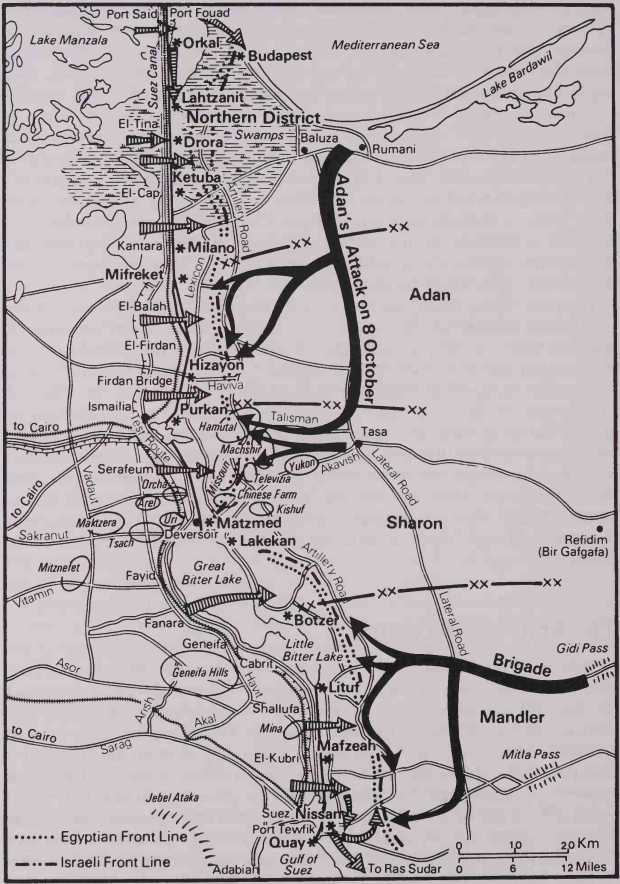Armed with the authority of the Prime Minister, General Elazar proceeded to Southern Command in the evening of 7 October, and presented the plan for a counterattack against the Egyptian forces on the eastern bank of the Suez Canal on the following day. The Command order was to launch a concentrated divisional attack rolling down from north to south along the east bank of the Canal, but leaving a distance of some two miles between the Canal and the right flank of the attacking forces in order to avoid the danger of infantry anti-tank fire from the Canal-side ramparts. The plan called for an attack by Adan’s division against the Egyptian Second Army, striking south from the area of Kantara, with Sharon’s division being held in reserve in the area of Tasa. Should Adan’s attack succeed, Sharon would then launch an attack against the Egyptian Third
Army, moving from the area of the Great Bitter Lake southward. Should Adan’s attack be unsuccessful, however, Sharon’s forces would be thrown in to reinforce it. Elazar emphasized that Sharon’s forces would be held as a reserve to Adan’s northern attack and their activation would be subject

Israeli Attack on Egyptian Bridgeheads, 7 and 8 October
To his, Elazar’s, personal approval; furthermore, the attacking forces should not reach the Canal, because of the danger of infantry anti-tank fire from the ramparts. It was assumed that, should the attack be successful, it might be possible to effect a limited crossing to the west bank at the southern extremity of each sector.
Adan’s division was deployed along the main lateral road, namely the Baluza-Tasa road. His first brigade (Amir’s) was to move southwards between the Canal road and Artillery Road, to destroy the enemy in the area and reach the fortifications opposite Firdan and Ismailia respectively. On the left flank of this brigade, but still west of Artillery Road, Colonel Natke Nir’s brigade was to advance southwards towards the Purkan fortifications opposite Ismailia. A third brigade, commanded by Colonel Arieh Keren, was to move southwards east of Artillery Road towards Matzmed, at the northern extremity of the Great Bitter Lake, where a limited crossing of the Canal would be attempted on Egyptian bridges if they were taken intact. After the destruction of the enemy forces by Adan’s division, Brigadier-General Magen’s forces were to come in from the north and mop-up along the east bank of the Canal.
The forces moved from north to south according to plan, but, as the morning advanced, it became clear that Adan’s forces were in fact moving too far to the east along Artillery Road and away from the bulk of the enemy forces. This mistake was not corrected in time; as a result, instead of rolling down the northern flank of the narrow Egyptian bridgehead and hitting the Egyptians where they least expected it, the massed forces of Adan’s division were moving across the front of the Egyptian bridgehead. And thus, when they turned towards the Canal, their attack developed from east to west — right into the Egyptian positions waiting for them.
The first to join battle was Amir’s force at about midday, which was engaged by hundreds of Egyptian infantry firing anti-tank weapons at short range, who appeared out of the sand dunes. The leading battalion withdrew, leaving twelve tanks burning on the battlefield.
Meanwhile, because the main force was moving too far to the east across the front of the concentrated Egyptian forces, and was not encountering any serious resistance, the impression gained at Gonen’s headquarters was that all was going well. Thus, at 11.00 hours, he ordered Sharon’s division to move southwards to the area of the Gidi Pass in order to hold it in readiness for a push against the Egyptian Third Army.
Meanwhile, in the early afternoon, Adan ordered a two-brigade attack (Nir’s and Amir’s) towards the Firdan bridge. Eight hundred yards from the Canal, Nir’s forces found themselves surrounded by thousands of Egyptian infantry, and eighteen of his tanks were set on fire and destroyed. Nir is an unusual example of perseverence and courage overcoming disability. While serving as battalion commander in the Six Day War, he had been seriously wounded in his legs, and had undergone more than twenty operations. He refused to be retired from combat duty, and by sheer perseverence was awarded a fighting command in a reserve tank brigade, despite his disability. Like the knights of old, he had to be assisted or hoisted in order to mount or dismount from a tank, but his
Bulldog nature brought him to a combat command. When he withdrew his forces from the inferno in which they found themselves in attacking in the direction of the Canal, only four tanks were capable of withdrawing with him.
No Israeli infantry or armoured infantry had been deployed in this attack, which had no air force support and which had only two batteries of artillery backing it. Facing this attack were the forces of the Egyptian 2nd Infantry Division, commanded by General Hassan Abu Saada, in coordination with the forces of the 18th Infantry Division reinforced by the anti-tank reserves of Second Army.
In the meantime, the Egyptians launched an attack on Keren’s forces to the south, in the general area of the northern end of the Great Bitter Lake, and occupied a number of Israeli strongpoints. And, in addition, two Egyptian counterattacks each comprising a mechanized brigade and a tank brigade, one from the area of the Firdan bridge and one from the south towards the Ismailia road, were mounted against Adan’s forces. Adan authorized Amir and Nir to improve their positions by making tactical withdrawals and, at about 14.00 hours on 8 October, Gonen realized that Adan’s attack had been a failure. He therefore ordered Sharon to return from the southern to the central sector — so Sharon’s division had spent a critical day travelling southwards and northwards without in any way exercising influence on the battlefield. Meanwhile, Adan’s division was fighting back the Egyptian counterattack. As the sun, which was blinding the Israeli forces, set, visibility improved and the Egyptian attackers suffered very heavy casualties among their tanks and armoured personnel vehicles. The Egyptian counterattack was halted.
It was clear now to the Israeli Command that they must conserve forces and allow time for the reserve army to deploy with all its supporting arms. Many errors in Israeli military thinking, particularly that of the armoured forces, were highlighted by the developments on 8 October. The Israeli armour mounted what looked like old-fashioned cavalry charges, without infantry support and with inadequate artillery support. This made no sense whatever in the face of the masses of anti-tank weapons that the Egyptians had concentrated on the battlefield. Again, Adan’s armoured force was at no stage concentrated, but frittered away piecemeal. Had Southern Command mounted a two-divisional attack concentrated against the area of the Firdan bridge with the necessary support, it could well have succeeded in punching a hole in theJEgyptian lines from which the Israeli forces could then have rolled up the Egyptian bridgehead from its flanks. The Israeli forces on that day suffered heavy casualties and lost a number of important positions, and the day’s fighting represented a lost opportunity. On a personal level, the events of 8 October were to bring to expression the very difficult relationship between Sharon and GOC Southern Command, General Gonen, not to mention open mistrust and hostility that developed between him and the General Staff and his other divisional commanders. On Tuesday afternoon, 9 October, Sharorf’s forces attacked the Egyptians in order to retake a second-line fortification that had fallen to the Egyptians the day before. Despite Gonen’s instruc-
Tions to him to stop the attack, Sharon persisted in developing it, with the result that Gonen requested from the Chief of Staff that Sharon be relieved of his command.
Meanwhile, Amnon Reshefs brigade, under command of Sharon, was now facing the so-called ‘Chinese Farm’ (an experimental agricultural area in which Japanese instructors had been used before the 1967 War; seeing Japanese inscriptions on the walls, the Israeli troops, not particularly well versed in East Asian scripts, had named the place ‘Chinese Farm’). Reshefs units and the divisional reconnaissance unit attached to them, continued their probing, reaching the water’s edge along the Great Bitter Lake and then turning northwards towards the Chinese Farm, hugging the edge of the lake. On the morning of 10 October, however, the reconnaissance forces were ordered to withdraw from this area because it was obvious to the Israeli Command that, unbeknown to the Egyptians, these probes had revealed the boundary between the Egyptian Second and Third Armies — and the soft underbelly of Second Army.




 World History
World History









